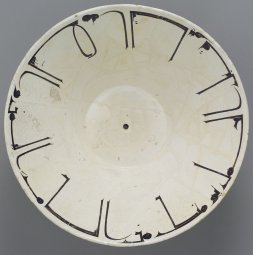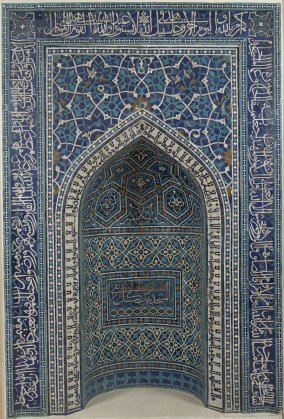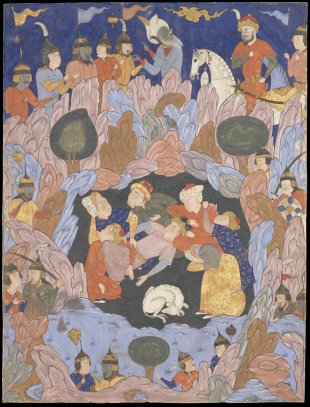 The reopening, after eight years, of the Islamic galleries at New York’s Metropolitan Museum of Art has brought considerable fanfare. Aware perhaps that some Muslims—whose worship spaces are conspicuous for their imageless interiors—might take offense at such spectacularly beautiful works being labeled “Islamic,” the Met has chosen instead to title the collection “Art of the Arab Lands, Turkey, Iran, Central Asia, and Later South Asia.” That clumsy but capacious label enables the curators to display everything from exquisite bowls, jugs, and goblets with little or no religious significance to beautifully calligraphic Qur’ans, sections of mosques, and extravagant miniatures illustrating the largely secular history of the kings of pre-Islamic Iran. I recently spent several hours viewing the collection, guided by the exhibit’s accompanying volume, Masterpieces from the Department of Islamic Art in the Metropolitan Museum of Art, expertly edited by four specialists: Maryam Ekhtiar, Priscilla Soucek, Sheila Canby, and Navina Najat Haidar.
The reopening, after eight years, of the Islamic galleries at New York’s Metropolitan Museum of Art has brought considerable fanfare. Aware perhaps that some Muslims—whose worship spaces are conspicuous for their imageless interiors—might take offense at such spectacularly beautiful works being labeled “Islamic,” the Met has chosen instead to title the collection “Art of the Arab Lands, Turkey, Iran, Central Asia, and Later South Asia.” That clumsy but capacious label enables the curators to display everything from exquisite bowls, jugs, and goblets with little or no religious significance to beautifully calligraphic Qur’ans, sections of mosques, and extravagant miniatures illustrating the largely secular history of the kings of pre-Islamic Iran. I recently spent several hours viewing the collection, guided by the exhibit’s accompanying volume, Masterpieces from the Department of Islamic Art in the Metropolitan Museum of Art, expertly edited by four specialists: Maryam Ekhtiar, Priscilla Soucek, Sheila Canby, and Navina Najat Haidar.
Three items stand out as superb examples of the artistic genius of Muslims over the centuries since 610 CE, when Muhammad began to experience the divine locutions that eventually called him and his followers to monotheism. Catching my eye right away, in the introductory space to the exhibit, was a white earthenware bowl (above right), eighteen inches in diameter, dating from the tenth century in northeastern Iran. Ornamented with elegant Arabic calligraphy around its rim, the bowl exemplifies a decorative technique called slip painting, in which, after being fired, an object is coated with a thin suspension of white clay particles in water, a mixture that looks a bit like heavy cream. When that suspension dries, the calligraphy is painted on the white background, in this case with dark brown pigment. A transparent glaze haloes the final product with an unearthly aura. The exhibition catalogue informs us that the bowl’s inscription—“Planning before work protects you from regret; good luck and well-being”—derives from a hadith, an oral tradition ascribed to Muhammad. The advice is something every cook will understand, and testifies to the likelihood that the bowl, its luminescent beauty notwithstanding, actually served as a kitchen utensil.
 One of the most impressive and attractive items in the museum’s collection is a fourteenth-century mosaic of polychrome glazed tiles that once decorated the niche (mihrab) in the wall of a mosque in the city of Isfahan in Iran (left). A mihrab is an indentation in an inner mosque wall that indicates the direction of Mecca and therefore of Muslim worship; within Mecca itself, a mihrab indicates the direction of the shrine that focuses the attention of that city and of the entire Muslim world, the Ka‘ba. More than eleven feet tall and nine feet wide, this mihrab was removed from Iran in the late 1920s, during the early years of the so-called Pahlavi dynasty. Over the next decade it traveled to Philadelphia and London before settling at the Met in 1939.
One of the most impressive and attractive items in the museum’s collection is a fourteenth-century mosaic of polychrome glazed tiles that once decorated the niche (mihrab) in the wall of a mosque in the city of Isfahan in Iran (left). A mihrab is an indentation in an inner mosque wall that indicates the direction of Mecca and therefore of Muslim worship; within Mecca itself, a mihrab indicates the direction of the shrine that focuses the attention of that city and of the entire Muslim world, the Ka‘ba. More than eleven feet tall and nine feet wide, this mihrab was removed from Iran in the late 1920s, during the early years of the so-called Pahlavi dynasty. Over the next decade it traveled to Philadelphia and London before settling at the Met in 1939.
The inscription around the niche’s outermost border derives from a late sura of the Qur’an mainly concerned with distinguishing Muslim Arabs from neighbors who persisted in their traditional religion, rejecting Muhammad’s message. It begins by defining who may and may not frequent a mosque: “The only ones who should tend God’s places of worship are those who believe in God and the Last Day, who keep up the prayer, who pay the prescribed alms, and who fear no one but God” (Qur’an 9:18). In a white band outlining the concave indentation of the niche, calligraphy in a geometric style calls down blessings on Muhammad and summarizes the five pillars of Islamic faith: first, the witnessing to the oneness of God and to Muhammad’s status as God’s unique messenger, then the ritual worship (salat), the annual poor-due (zakat), pilgrimage to the Abrahamic holy sites in Arabia (hajj), and the annual fast (sawm) of Ramadan. Both the outer and the inner border inscriptions serve as reminders of the essentials of Islamic faith, the requirements for entering the portal of faith that this mihrab symbolizes. In the inmost recess Muhammad is quoted observing that “the mosque is the abode of every pious person.” These inscriptions make the niche more than a pointer to Mecca; they serve as a reminder that in Islam geography has a sacred significance, pointing the faithful through its portal toward the House of God on earth.
The farther away from the Arab lands these works of art were created—especially if they were created in the fifteenth century or later—the more likely they are to contain vivid imagery of human beings and animals. Of the many pictorial works displayed at the exhibit, one of the most fascinating is a large (more than 23 by 17 inches) folio from a sixteenth-century Falnama, or “Book of Omens.” Such a book was used in the divinatory technique called bibliomancy, which attempts to divine the unknown by the random opening of an illustrated book. This image, an opaque and gilded watercolor on paper, comes from a royal Falnama commissioned for that purpose by the second Shiite ruler of Iran, Shah Tahmasp of the Safavid dynasty, who succeeded his father Shah Isma‘il in 1524 and ruled for more than half a century. Though presumably done by a painter in Shah Tahmasp’s court, the work (below right), like so many Islamic artworks, is unsigned.
 Shiite Islam differs from Sunni Islam in many particulars, but nowhere more dramatically than in its devotion not only to Muhammad but also to his family, and especially the lineage of his twelve male descendants, regarded as impeccable Imams. The Twelfth Imam in that lineage, Muhammad ibn Hasan (often called “Muhammad the Expected One”), was hidden away from enemies around 874 CE, and devout “Twelver” Shiites await his return to set the world aright and inaugurate a period of just rule. Any passage of the Qur’an that emphasizes the return from apparent death of witnesses to God is of special interest to Shiites, since such figures suggest the potential for the Twelfth Imam’s return. This folio illustrates a story from the Sura of the Cave, a Meccan chapter of the Qur’an that takes its name from the ancient story of the Seven Sleepers, which appears both in Christian and Muslim sources. First-millennium sources gathered up in the Golden Legend of the thirteenth-century hagiographer Jacobus de Voragine tell how these seven Christian men took refuge in a cave near Ephesus from the persecution of the Emperor Decius in the third century. There the Emperor entombed them (and their dog), but they did not die. Instead they slept peacefully for two centuries, finally emerging to find themselves in the Byzantine Christian Empire of Theodosius II.
Shiite Islam differs from Sunni Islam in many particulars, but nowhere more dramatically than in its devotion not only to Muhammad but also to his family, and especially the lineage of his twelve male descendants, regarded as impeccable Imams. The Twelfth Imam in that lineage, Muhammad ibn Hasan (often called “Muhammad the Expected One”), was hidden away from enemies around 874 CE, and devout “Twelver” Shiites await his return to set the world aright and inaugurate a period of just rule. Any passage of the Qur’an that emphasizes the return from apparent death of witnesses to God is of special interest to Shiites, since such figures suggest the potential for the Twelfth Imam’s return. This folio illustrates a story from the Sura of the Cave, a Meccan chapter of the Qur’an that takes its name from the ancient story of the Seven Sleepers, which appears both in Christian and Muslim sources. First-millennium sources gathered up in the Golden Legend of the thirteenth-century hagiographer Jacobus de Voragine tell how these seven Christian men took refuge in a cave near Ephesus from the persecution of the Emperor Decius in the third century. There the Emperor entombed them (and their dog), but they did not die. Instead they slept peacefully for two centuries, finally emerging to find themselves in the Byzantine Christian Empire of Theodosius II.
A sick man seeking an omen in Shah Tahmasp’s court by picking this folio in the Falnama might have found hope in its message of survival—and the shah himself might have seen in it assurance that his reign would survive its many challenges from within and without. The center of the watercolor depicts the intertwined Seven Sleepers in their cave along with their dog. God, the speaker of this story in the Qur’an, assures Muhammad that “God will shower his mercy on you and make you an easy way out of your ordeal” (Qur’an 18:16). The threats to the faithful Seven Sleepers surround the cave on all sides, in the form of Roman soldiers who look distinctly Central Asian. But the Seven Sleepers outlive the enemies of their faith and offer hope to all who feel besieged by the forces of death. “We brought them to people’s attention so that they might know that God’s promise [of resurrection] is true and that there is no doubt about the Last Hour” (Qur’an 18:21).
It’s impressive to note that these fifteen galleries exhibit a mere 10 percent of the collection of Islamic art in the Met, and one hopes that additional treasures will emerge as this permanent installation evolves. But even 10 percent is an abundance, and I left feeling exhilarated. I found myself thinking about the late French Catholic Islamicist Louis Massignon and his long campaign to bridge the gap between Christians and Muslims. During the Algerian struggle for independence (1954–62), when French mobs murdered Algerians in Paris, Massignon started to lead an annual pilgrimage of Christians and Muslims to a church in Brittany dedicated to the Seven Sleepers of Ephesus. As recently as last July, Cardinal Philippe Barbarin, the Moroccan-born Archbishop of Lyon and Primate of the Gauls, led that same pilgrimage and preached there about a common theme in both Christian and Muslim scriptures: the mercy of God.
The reopened Islamic galleries of the Metropolitan Museum provide all people of faith, especially Christians and Muslims, with a place of pilgrimage only a few miles north of Ground Zero, a place where we can meditate on the beauty and mercy of God reflected in these precious artifacts from the far-flung Islamic world. The beauty of God mirrored in the simple but elegant proportions of a tenth-century kitchen bowl speaks to us. The portal to God’s mercy directs our hearts to God’s mysterious presence, not only in our human consciousness but in a sacred geography. And the mysterious dead who lived by faith awake from their sleep and offer consolation to all who live between fear and hope.
All images courtesy of the Metropolitan Museum of Art
